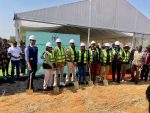In a significant stride towards transforming Namibia’s communal agriculture, the European Union (EU) and the Government of the Republic of Namibia today broke ground on a state-of-the-art N$78.9 million (approx. EUR 3.9 million) cattle feedlot at the Etunda Irrigation Scheme. The ceremony, attended by national and regional leaders, farmers, and development partners, marks a pivotal moment in a comprehensive N$400 million EU-funded programme designed to empower farmers in the Northern Communal Areas (NCA).
The 1,000-standing-cattle capacity Etunda Feedlot is strategically positioned near Ruacana to drastically reduce costs and logistical hurdles faced by communal farmers in accessing abattoirs and essential livestock services. Beyond mere infrastructure, the facility is envisioned as a critical off-take point, enhancing cattle quality and market readiness, and connecting NCA herders to local, regional, and potentially international value chains through Commodity-Based Trade (CBT).
Speaking at the event, Ian Dupont, EU Chargé d’Affaires to Namibia, underscored the deep-rooted partnership between the EU and Namibia. “This site is a prime example of our joint efforts to grow the livestock sector in the Northern Communal Areas,” Dupont stated. He highlighted the EU and its Member States as Namibia’s largest trade and development partner, collaborating across diverse sectors including agriculture. “This represents sustainable and inclusive development, aimed at bringing real empowerment to livestock farmers… Together, we want to support the building of systems and infrastructure so that farmers in the NCA can benefit from regional and international trade, such as through SACU or the AfCFTA.”
Dr. Inge Zaamwani, Minister of Agriculture, Fisheries, Water and Land Reform, emphasized the project’s alignment with core national objectives. She stressed that the Etunda Feedlot directly addresses Namibia’s goals of enhancing food security, reducing poverty, and building climate-resilient livestock management systems. The Minister acknowledged the collaborative effort involving her Ministry, the National Planning Commission (NPC) as the contracting authority, the Ministry of Works and Transport, and the EU Delegation in bringing the project to fruition.
Part of a transformative N$400 million package
The Etunda Feedlot is the flagship project within a far-reaching N$400 million EU support package targeting the NCA livestock sector. This ambitious programme encompasses six other major infrastructure projects currently under construction across four northern regions, following technical handovers facilitated by the NPC:
1. The modernization of the slaughterhouse in Opuwo (Kunene Region);
2. The renovation of quarantine facilities and a multi-purpose farm at Omutambo Maowe (Omusati Region);
3. The construction of an Artificial Insemination Centre at the Okapya Livestock Development Centre (Oshikoto Region);
4. The building of a new Agricultural Development Centre, Veterinary Office, and staff housing at Nkurenkuru (Kavango West Region);
5. The upgrading of the auction facility in Neaute (Kavango East Region); and
6. The enhancement of quarantine facilities and farm infrastructure in Katima Mulilo (Zambezi Region).
Building resilience and market access
Beyond bricks and mortar, the programme integrates vital support mechanisms to ensure long-term sustainability and resilience. Dupont detailed complementary investments already underway, including the recent handover of five 30-ton 4×4 heavy-duty trucks to the Ministry of Agriculture, with a further nine vehicles due soon, significantly boosting transport and logistics capacity across the sector.
The programme also actively supports Namibia’s existing investments in livestock traceability through the Integrated Animal Health Information System (IAHIS). Furthermore, it funds crucial aspects like farmer capacity building and mentorship in improved animal husbandry practices, and initiatives for fodder production aimed specifically at strengthening the production system’s resilience to the impacts of climate change.
A core objective, reiterated by both Dupont and Minister Zaamwani, is enabling NCA farmers to participate equitably in trade. This involves mitigating the risks posed by communicable diseases such as Foot and Mouth Disease (FMD) and Lumpy Skin Disease (LSD), where the veterinary cordon fence remains a key management tool. The upgraded infrastructure, coupled with enhanced traceability and veterinary controls provided by the new facilities, is designed to keep these risks at bay while facilitating safe market access.
A call for community ownership
Dupont extended sincere gratitude to the tireless staff of the NPC, the Ministries of Agriculture and Works, his EU Delegation colleagues, and the engineers who translated the infrastructure vision into reality. He concluded with a direct appeal to regional governors, councillors, and community leaders present: “Encourage your communities to fully utilize these infrastructures once completed. Their proper use will uplift farmers in the Northern Communal Areas, create much-needed jobs, and contribute significantly to the growth and resilience of Namibia’s economy.”
The groundbreaking ceremony, witnessed by a broad coalition including traditional authorities, farmers’ unions, and local community members, stood as a visible testament to the cross-sectoral support for this transformative initiative. The shared belief, as articulated by Dupont, is that this partnership paves the way for “a stronger, more productive, and climate-resilient livestock sector and functional market” for the farmers of Namibia’s north, fully aligned with the goals of the national development agenda, NDP6. The Etunda Feedlot is more than a facility; it symbolizes a concrete step towards unlocking the vast potential of communal livestock farming in Namibia.










